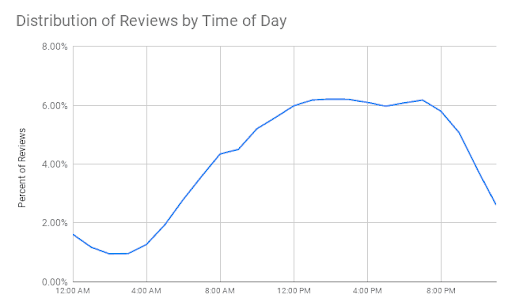WRITTEN BY: SABRINA SCHNURR
Why you need to start collecting reviews
Having a mechanism for gathering and prominently displaying glowing testimonials can quickly turn customers into your very own brand ambassadors. In the climate of today’s digital overload, consumers are less inclined to outright believe the promises you make. Instead, potential clients will search through various sources to get trustworthy information about you and your brand – and customer reviews will be the first stop. Why should customer reviews be the backbone of your online marketing?
- 4 in 5 American consumers read reviews before making a purchase decision.
- Reviews have a longer shelf life than a tweet or Facebook post.
- More reviews will help you rank higher in search results. Google and industry experts all say that a business’ review signals — such as review count, ratings, and review text — are factored into local search rankings. Which means just a small increase of 1 to 8 reviews can lead to significant improvements in conversion rates. According to the 2018 Local Search Ranking Factors report by SEO software company Moz, online reviews are now one of the top 3 most important ranking factors in local search.
What platform to use
In order to generate new reviews and collect valuable customer feedback, more and more businesses are creating their own dedicated landing pages for reviews. These landing pages can be facilitated through the use of review generation software, survey forms, an embedded reviews widget on your company website — or you can build one on your own. Since Google is the review site of choice, you might want to create a Google Reviews Link for the same effect. Then, you can share the link to this page across your social media channels and send it out to your email database.
But don’t forget about third party platforms! Dedicated review sites like Yelp, Trustpilot, TripAdvisor, and Google My Business are some of the first places a person will visit to provide feedback, so each business should ensure their details on these platforms are correct and up to date. Facebook is another excellent platform for attracting feedback, provided you have an account set up for your business. The key is to hand the consumer a wealth of options which will give them the best possible chance to leave positive feedback.
Remember, quality over quantity. While it is important to appear on as many channels as possible, you also want to leave a great impression on each site. This means that if you cannot keep up with five to six different sites to consistently update, start with two or three and work your way up. One clean, concise, and user-friendly page is always better than several confusing and out of date sites.
When to ask
The two best times to ask for reviews are between 2-3 PM and 6-7 PM in the middle of the week. These are the times consumers are most likely to rate a business on Google. People are often visiting businesses during their lunch break or after work, so these hours are the exact times that consumers are reflecting on their experiences. However, it’s always best to test, measure, and adjust.

How to ask
1. Request a review via email
Requesting via email is one of the most effective ways to generate reviews, especially if you’re just getting started. As much as 70 percent of reviews come from post-transactional review request emails. Email campaigns usually take the form of customer feedback surveys or simply contain a link to a page where the recipient can write a review. The best part? Email requests allow you to tie each review to a transaction that happened and ultimately demonstrates authenticity to potential customers.
Tips:
- Keep it short. Keep it simple. People are less likely to fill out an entire 30-minute survey.
- If you’re asking for a rating, make it the first question. You want a gut reaction to aid honesty and prevent overthinking.
- Provide pre-written or multiple-choice answers. Open-ended questions tend to push reviewers away, as they take more time and energy to fill. If you require more elaborate responses, leave an optional “please explain” box after the question.
- Try to use rating scales instead of yes/no questions. A scale allows the reviewer an “out”, or middle ground when they do not feel strongly.
- If you or someone at your company knows a client personally, ask them individually (and face-to-face).
- Automate! Automate! Automate! Set a schedule for request emails to be sent out immediately to new clients or to all customers every few months. You can do this with texts too. (see below)
- The magic is in the subject line. Try something such as “How did we do?” or “We’d love to hear your feedback!”
2. Request a review via text message
56 percent of all online reviews are posted from mobile devices. If you send customers a text message survey, there’s a good chance they’ll click on that link. Text messages are opened at a 98 percent rate, whereas email typically has a 20 to 30 percent open rate.
Tips:
- Because of the character limits on text messages, you’ll need to be extra careful with the wording for your request. As always, keep it short and simple.
- Try this template: “Hey (First Name of Customer), thank you for visiting (Business Name) today. To help us best serve you and others, could you click on this link (review website profile link) to answer one question about your experience today? Thanks!”
Every company will receive negative reviews that will inevitably drive people away from your business. That’s why it’s essential to develop a strategy for dealing with unhappy reviewers and poor feedback. We suggest you 1) monitor your social channels so that you can react quickly, 2) address specific comments with an apology or explanation if appropriate, and 3) resolve the issue quickly so no one makes the same complaint.
Takeaway
A positive review can work wonders for your company. Customer reviews offer a narrative of what it is like working with you, and most potential customers will expect to find reviews on Google when considering your company. Great reviews build a reputation of trust, reliability, professionalism, and a strong connection with your clients. Thus, leveraging your current and past clients is the key to growth and success for your future.
Do not forget to respond to reviews! 53 percent of customers expect businesses to respond to negative reviews within a week. Responding to both good and bad reviews shows potential clients that you are truly invested in building trustworthy professional relationships.
Have more questions? Direct Development is here to help you manage your company’s social media pages.









